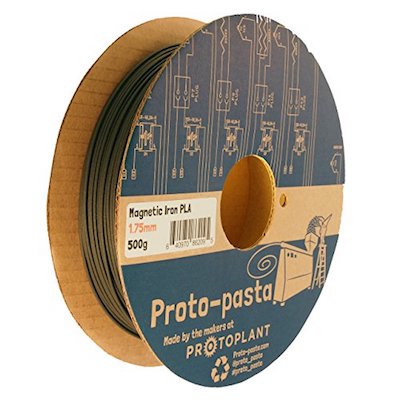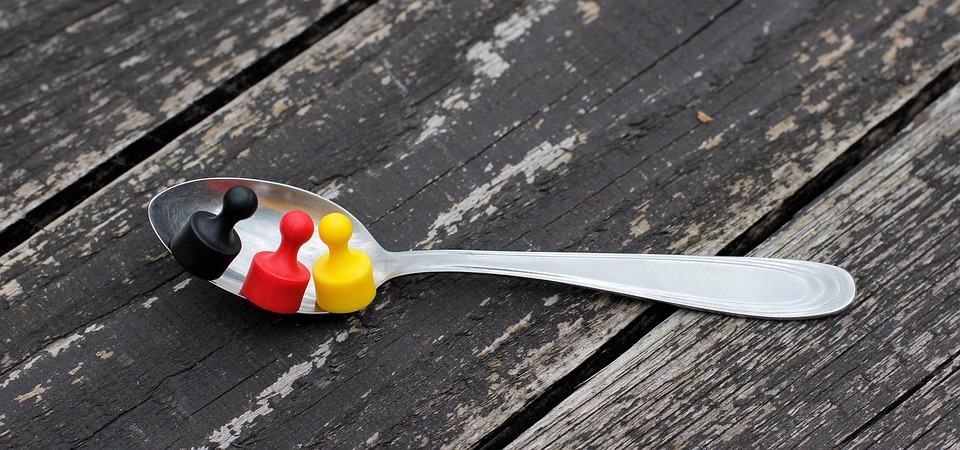Magnetic Filaments: Properties, Applications, How to Use Them, and Best Brands
Perhaps one of the longest lasting beliefs that we have held since we were children can be summarized in three words: magnets are awesome. They make nifty toys and trinkets but are also the force behind many technological advancements in the modern world. All many of us want to do is to make our very own custom-designed magnetic prints. With just a spool or two of magnetic filaments, and a few tweaks on your 3D printer, you can also make your own magnetic toys (plus other more useful stuff).
What are magnetic filaments?
Magnetic filaments are made by infusing finely ground iron powder to a base material. Although other base materials can be theoretically used, the magnetic filament products available in the market today use PLA. This allows us to make 3D prints that act much like metals in terms of their response to a magnetic field. Prints using magnetic filaments are described as ‘ferromagnetic’ – that is, they are attracted to magnetic fields.
Do take note that there is a difference between magnets and ferromagnetic materials. Prints made from magnetic filaments will be attracted to magnets, but do not by default act as magnets on their own.
What are the benefits of using magnetic filaments?
Using magnetic filaments opens up a whole new world of 3D printing. Aside from making your own magnetic trinkets and other nifty items such as magnetic stirrers, magnetic filaments can also be used to make various mechanical and engineering parts. Replacement parts of magnetic sensors and actuators for automated systems can be easily printed, instead of having to order new parts. Some enterprising individuals have even started testing the use of magnetic filaments to make custom-made stators for brushless motors, or various forms of magnetic storage media.
If you are creative, then the possibilities are practically endless for prints made from magnetic filaments. Magnetic prints have made their way to home fixtures, fashion accessories, and costumes.
In terms of the printing experience, magnetic filaments are actually very forgiving of different printing conditions. The prints have good rigidity and can handle minor overhang features with no problems. Prints made from magnetic filaments can have either matte or glossy finishes depending on the printing temperature. Either way, magnetic prints end up with a striking and unique finish.
A finishing method that can only be uniquely done with magnetic filament prints is a process called ‘rusting’. In this method, the iron particles in the print are literally allowed to rust, giving a weathered and very interesting finish. To do this, you only need to rub the outer layers of the print with an abrasive material, such as sandpaper, to expose the iron particles. Although rusting can proceed spontaneously, you can accelerate the process by submerging the print in a saline solution for 2 to 3 days.
How do you use magnetic filaments?
The recommended printer settings when printing with magnetic filaments are similar to those of the base material, PLA. This means that a printing temperature within the range of 215 to 225 °C should suffice. Depending on the ratio of PLA to iron in the filament you are using, you may have to play around with the printing temperature settings to get the best results. If in doubt, it is best to ask for the recommendations from your filament manufacturer.
A heated bed is not necessary when printing with magnetic filaments, but you can use on if you desire to do so. A bed temperature of around 60 °C should do well enough when printing with magnetic filaments.
Rapid cooling tends to result in warping when printing with magnetic filaments. We recommend starting your prints with no cooling fan, at least for the first two layers. You can then start inching up your fan settings, perhaps to around 10% to 20%. You can also play around with the printing speed to avoid warping of your print. Some users have reported getting good results with high printing speeds of 60 to 80 mm/s, but we recommend starting at a very low speed (10 to 20 mm/s) and working your way up. Again, this will vary with the filament brand you are using, so you can always ask your filament manufacturer for their recommended settings.
As with other infused filaments, the powdered iron in magnetic filaments is hard and can be very abrasive. Thus, stock extruder nozzles that are made of brass will likely be worn down very quickly when used with magnetic filaments. We recommend using a 100% heat-treated steel nozzle which is durable enough to withstand the abrasive properties of powdered iron. A larger nozzle diameter (at least 0.4 mm) is also recommended to reduce the effects of abrasion.
Should you decide to use a steel nozzle, you will have to take into account the lower thermal conductivity of steel compared to brass. This tends to cool down the molten filament upon contact, resulting in under-extrusion or clogging. To avoid this, you may use a printer temperature that is about 20 to 40 °C higher than the temperature recommended for the base material.
What are the drawbacks of using magnetic filaments?
There are not many magnetic filament products out there, and the few that are available may vary in terms of the optimal printer settings that they work in. This means that working with magnetic filaments may take a lot of tweaking and experimentation. That being said, it is quite a forgiving material which can still produce good prints even in less than ideal conditions.
As already mentioned, magnetic filaments are quite abrasive which means that you will likely have to replace the stock extruder nozzle of your printer with one that is more durable. It’s not a very expensive replacement, but it is an added expense nonetheless.
Magnetic filaments are also quite rigid because of the powdered iron infused with the PLA. This also makes it too brittle to negotiate very tight corners along the filament path of some printers. To avoid having your filament break during printing, it would help to ensure that the filament path only consists of smooth and gentle curves from spool to the nozzle.
The presence of powdered iron in the filament does not necessarily results in prints that are stronger. If anything, prints made from magnetic filaments are probably a little weaker than those made from standard PLA. Magnetic filaments also cannot act as suitable replacements for truly conductive materials since the iron powders are too small and isolated from each other in a matrix made from non-conductive PLA. For applications that require conductivity, a special conductive filament should be used.
Many users have explored the possibility of turning prints made from magnetic filament to actual magnets. Although it is theoretically possible to turn ferromagnets to permanent magnets, the high electric current needed to achieve this will end up melting your print. You may instead try to magnetize your print by rubbing it against a magnet. This process, called hysteresis, exposes your ferromagnetic print to a varying magnetic field and allows it to hold a magnetic field of its own. However, this magnetic field will dissipate over time. At best, hysteresis can give you a very cool, but temporary, magnet.
What are the best brands of magnetic filaments?
Magnetic filaments are what you would “specialty” filaments. Not many people buy or use them, as they only serve very special needs. Hence, there are really only two reputable brand names of magnetic filaments in the market today.

Proto-pasta has a varied selection of their Rustable Magnetic Filament line. Their magnetic filaments come in two colors, black and gray. Their variety of sizes should serve any and all types of users: the filaments are available in both 1.755mm and 2.85mm sizes and are sold in spools of 125g and 500g. If you are only just starting to print using magnetic filaments, we recommend getting the 125g spool just so you can take it out for a spin.

The Ferromagnetic PLA filament from Black Magic 3D has been the material of many studies and experiments using magnetic filaments. It is a “one size fits all” product – there are no special variations or alternative sizes. Feedback on this product has been great all around, with most users stating that it was quite easy to work with. The magnetic filament from Black Magic 3D is available only at 1.75mm size and sold in 350g spools. Take note that magnetic filaments are naturally heavy, so a 350g spool contain more filament than you are probably expecting.
The Roundup
| Material | Magnetic filament |
| Properties | – Attracted to magnets (ferromagnetic) – Good rigidity – Can be finished with either a matte or glossy look – Can undergo rust finishing |
| Applications | – Magnetic toys and trinkets – Magnetic sensors and actuators – Magnetic stirrers – Magnetic storage devices – Stators for small motors |
| Recommended printing temperature | 215 to 225 °C; may be higher if a steel extruder nozzle is used |
| Recommended bed temperature | No heated bed necessary, but 60 °C is optimal |
| Printing speed | 60mms to 80 mm/s; starting low (10mm/s to 20mm/s) is recommended for the first two layers |
| Cooling | No cooling fan is recommended; a setting of 10% to 20% may be used at later parts of the print |
| Nozzle material and diameter | Nozzle has to be made of durable material – we recommend 100% steel. A wide nozzle is recommended, about 0.4mm. |
We have to admit that magnetic filaments are ‘niche’ products – not many people will have a need for them, and even less will buy them regularly. However, it is nice to have the possibility of creating magnetic prints, should that be a necessity. These products also open up a world of possibilities for people in creative or engineering domains.
In any case, magnetic filaments represent a step forward for the 3D printing industry. It makes us excited for what else the technology can be capable of in the future. If you’re an experienced user of a 3D printer who has gotten tired of printing using the standard PLA or ABS, then maybe it’s time to expand your horizons and use a filament that is less conventional.






